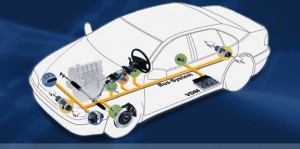Understanding the CAN Bus: A Beginner’s Tutorial
The Controller Area Network (CAN) bus is a robust communication protocol designed for vehicles and industrial applications. Developed in the 1980s by Bosch, it facilitates real-time data exchange between different microcontrollers without requiring a host computer. This tutorial introduces the basics of the CAN bus, its functionality, and how to work with it.
What is the CAN Bus?
The CAN bus is a multi-master, message-oriented protocol. It is widely used in automotive and industrial environments because of its reliability, flexibility, and efficient data transfer capabilities. It enables devices like electronic control units (ECUs) in cars to communicate without needing a central computer.
Key Features:
- Error detection: Built-in error checking ensures data integrity.
- Multi-master capability: Any device on the network can send messages.
- Priority-based arbitration: Messages with higher priority get access to the bus first.
- Two-wire differential signaling: Provides robustness against electrical noise.
How Does the CAN Bus Work?
- Message-Oriented Communication:
- Devices (nodes) on the CAN bus send and receive messages, not addressed to specific recipients but broadcast to all.
- Each message contains an identifier that indicates its priority and type.
- Two-Wire System:
- The bus consists of two lines: CAN_H (high) and CAN_L (low).
- The voltage difference between these lines carries the data, ensuring reliable communication even in noisy environments.
- Arbitration:
- If two nodes attempt to transmit simultaneously, the message with the higher priority identifier continues while others back off.
Structure of a CAN Frame
A CAN frame is a unit of data transmitted on the CAN bus. The standard CAN frame contains the following fields:
- Start of Frame (SOF): Indicates the beginning of a frame.
- Identifier: Determines the priority of the message.
- Control Field: Specifies the type and length of the data.
- Data Field: Contains up to 8 bytes of data.
- Cyclic Redundancy Check (CRC): Ensures data integrity.
- ACK Field: Indicates successful reception of the frame.
- End of Frame (EOF): Marks the end of the frame.
Setting Up a CAN Bus System
To start working with a CAN bus system, you’ll need the following:
Hardware:
- CAN Transceiver: Converts digital signals from a microcontroller to CAN-compatible signals.
- Microcontroller with CAN Controller: Interfaces with the CAN transceiver.
- CAN Bus Cables: Twisted-pair cables for CAN_H and CAN_L.
- 120-Ohm Termination Resistors: Placed at both ends of the bus to prevent signal reflections.
Software:
- CAN device decode information.
- Tools for debugging and monitoring (e.g., PCAN, CANalyzer).
Steps to Implement:
- Connect Nodes: Wire the devices to the CAN bus using twisted-pair cables.
- Setup Transceivers: Attach CAN transceivers to the microcontrollers.
- Configure Software:
- Set the baud rate (e.g., 1 Mbps, 500 kbps).
- Define message IDs and data payloads.
- Add Termination Resistors: Connect 120-ohm resistors at both ends of the bus.
- Test Communication: Use debugging tools to monitor and verify message exchanges.
Checking Line Resistance (Between CAN High and CAN Low) should read 60 ohms.
 |  |
Products:
SG-1-C Strain Gage Amplifier to CAN
LINC Smartphone and Tablet Bridge
11148 Treynorth Drive
Suite A
Cornelius, NC 28031
(704) 769-0001
Maximize Your Metrics with Techmor's Measurement Toolsre

Contact Us
Precision metrics measurement is a critical aspect of many industries, particularly in the automotive sector where accuracy and consistency are essential to ensure quality and safety. From engine performance to vehicle emissions, precise measurements are crucial for meeting regulatory requirements, improving efficiency, and enhancing the overall driving experience.
One of the most significant challenges in precision metrics measurement is achieving the level of accuracy required for reliable results. This requires careful calibration of measurement instruments, as well as attention to environmental factors such as temperature and humidity that can affect the accuracy of measurements. In addition, data analysis and interpretation play a critical role in determining the relevance and usefulness of measurement data.
Automotive applications of precision metrics measurement include everything from engine testing to fuel efficiency analysis, emissions testing, and more. Advances in technology have enabled more precise and efficient measurement techniques, such as the use of laser-based sensors and automated testing systems that can perform measurements quickly and accurately.
One of the most promising areas of development in precision metrics measurement for automotive applications is the use of artificial intelligence (AI) and machine learning (ML) to automate data analysis and interpretation. By using algorithms to analyze large amounts of measurement data, AI and ML can provide valuable insights into vehicle performance, identify areas for improvement, and help automotive manufacturers develop more efficient and reliable products.
Overall, precision metrics measurement and its applications in the automotive industry are critical for ensuring quality, safety, and efficiency. Advances in technology and the use of AI and ML are likely to play an increasingly important role in the future of precision measurement and automotive development.
Copyright 2024 Techmor Inc.


